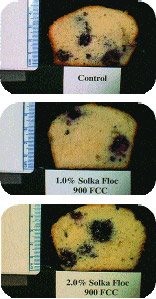
"Functional fiber forms fibrous networks in the muffin," explains Jit Ang, Ph.D., senior vice president, research and development, International Fiber Corp., North Tonawanda, N.Y. "It works well in any chemically leavened baked product."
The length of the fiber used for baking is relatively long--120 microns on average--which gives it functional ability. Adding up to 2% Solka-Floc R 900 FCC cellulose fiber to muffin batter gives bakers several types of functional advantages that can lead to improved quality and better economy.
The company performed a series of trials on blueberry muffins--utilizing levels from 0.5% up to 2% in 0.5% increments--to determine how cellulose fibers improved the product. Batter with added cellulose had a lower specific gravity and was more viscous than the control, which indicates a greater ability to incorporate air into the batter. Indeed, when researchers checked volume using the displacement method, they found that the muffins containing cellulose had greater volume. At 0.5% cellulose addition, volume increased 16%, and at 2% cellulose addition, it increased 32%. Texture of the muffins was lighter and less dense.
There was less bake loss as the cell-ulose level increased. Bake loss is the measure of moisture that is lost from batter to finished product. Blueberry muffins are moister than some other types of muffins because of their fruit content. Cellulose holds onto the moisture and lengthens the shelf life of the muffins.
There was no difference in browning or flavor of the muffins, as cellulose fiber is very bland and does not affect the flavor of the batter or the fruit.
Food scientists performed several American Association of Cereal Chemists (AACC) quality tests on the muffins. The Symmetry Index, which indicates the height of the muffin, was higher than the control. The crown continued to get higher at 0.5% and 1% cellulose, while at 1.5% and 2%, it got a little lower.
"The baker can engineer the shape of the muffin to have a higher or lower crown," Ang says. "Some people like muffins with a high crown and some like a lower, more rounded top."
Researchers also looked at the Uniformity Index, a measure of even shape on all sides of the muffin top. They found that at 0.5% and 1% cellulose, the tops were less uniform than the control, while at 1.5% and 2% there was greater uniformity.
International Fiber Corp. is the result of a merger between International Filler Corp. and Fiber Sales and Development. Headquartered at its manufacturing plant in North Tonawanda, N.Y., the company boasts additional plants in Nitro, West Virginia; Urbana, Ohio; and Temse, Belgium, and will offer the food industry blending systems and new fibers, according to Robert Hayward, vice president, sales and marketingfood.
"Our new sophisticated blending system will combine fiber with other food ingredients for additional functionalities," he says. "Other fibers are also in the works--wheat, soy and oat, in addition to the cellulose fiber we've always had."